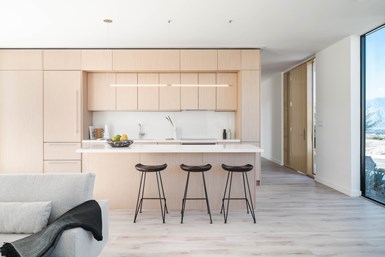Mighty Buildings completes 3D-printed zero net energy home, expands B2B growth
Fiber-reinforced 3D-printed home incorporating the panelized Mighty Kit system is part of a future community of 40+ units designed to provide environmental and economic benefits.
Mighty Buildings Inc. (Oakland, Calif., U.S.), a technology company construction sustainable, high-quality 3D-printed homes has completed the delivery of a fiber-reinforced 3D-printed home designed as zero net energy (ZNE) from its inception. The company also plans to expand its B2B operations to empower housing developers to build communities of sustainable homes at scale.
The two-bed/two-bath home is the first in the 40+ unit community in Southern California and is said to be the world’s first ZNE home built using prefabricated 3D-printed panels (from Mighty Building’s Mighty Kit System). A ZNE home is classified as a home that will produce at least as much energy through clean, renewable resources as it consumes. According to Mighty Buildings, this sustainable solution provides important benefits for developers, homeowners and the environment.
The Mighty Buildings panel-based system reduces on-site construction time by more than half, creating immediate value to developers and end-users of the home. Thanks to the company’s concrete-free materials, Mighty Home’s walls are made from 60% recycled material, are said to require less material per square foot of home and generate as much as 99% less waste than traditionally built homes. Pre-production and ready-to-assemble kits minimize preparation and sourcing time, which creates additional benefit in light of scarce resources and supply constraints (learn more “3D-printed prefab homes aim to disrupt construction market”).
In addition to the technical benefits, Mighty’s system also enables developers to incorporate unique 3D-printed designs while providing climate resiliency. A Mighty Home is designed to resist hurricane winds, high water, fire, mold, insects and extreme temperature.
“We are excited to complete what we believe to be the sustainable housing standard in the future. As a result, housing developers will no longer have to choose between profitability, quality, design and protecting the planet,” Mighty Buildings CEO, Slava Solonitsyn, says. “The first 3D-printed ZNE home ever built is a result of years of R&D processes, including creation of a proprietary, certified construction technology and a revolutionary alternative to concrete which provides drastically lower thermal conductivity. Our manufacturing technology features a high degree of automation and advanced robotics, enabling us to reduce the completion time by more than half. In this way, the entire home can be constructed within four to five months, significantly accelerating on-site completion and resulting in happier home buyers, more productive on-site workers and higher returns for developers.”
To accelerate the transformation to climate-friendly construction, Mighty Buildings is focusing on B2B partnerships with home developers in the U.S. and worldwide. This reach will enable Mighty Buildings to scale rapidly with communities of 50+ units in multiple locations.
Related Content
-
Carbon fiber, bionic design achieve peak performance in race-ready production vehicle
Porsche worked with Action Composites to design and manufacture an innovative carbon fiber safety cage option to lightweight one of its series race vehicles, built in a one-shot compression molding process.
-
Pultrusion: The basics
A primer describing what pultrusion is, its advantages and disadvantages, and typical applications.
-
Sulapac introduces Sulapac Flow 1.7 to replace PLA, ABS and PP in FDM, FGF
Available as filament and granules for extrusion, new wood composite matches properties yet is compostable, eliminates microplastics and reduces carbon footprint.



















